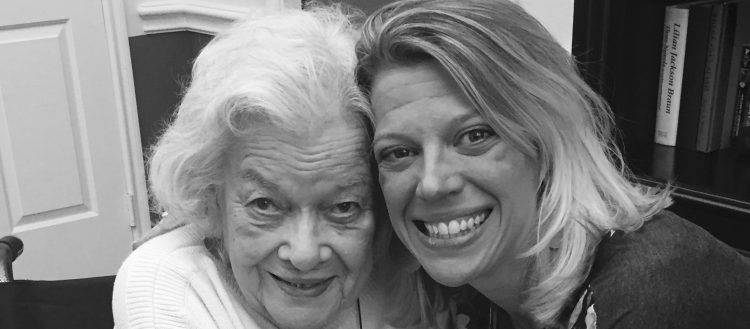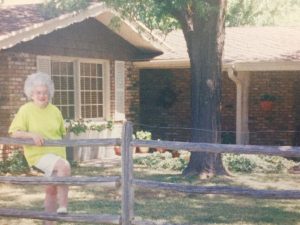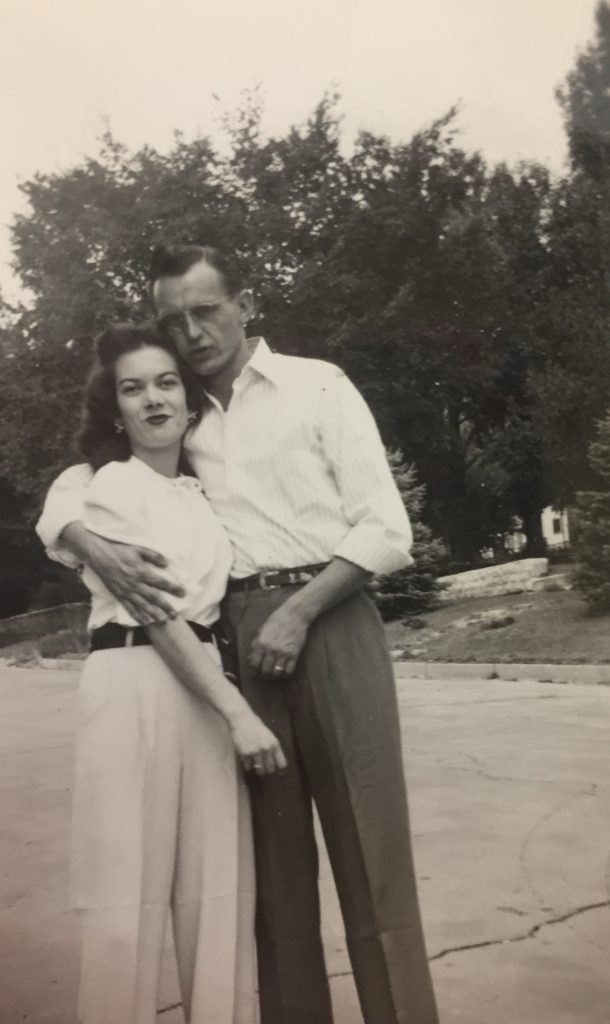
Depression glass, silk flowers, a screened back porch door that slammed if you weren’t careful, wintergreen gum tucked into the drawer of an apothecary cabinet, black and white photos of my grandfather with the faintest hint of red lipstick on the glass, tiny bottles of perfume on a mirrored tray, a bass bed so high off the ground a child would have to run and hurdle to get into it, plates of fudge, handpainted china in a glass cabinet, crystal bowls of sugared candy on marble top cabinets, a hand-carved white shelf above the tub that I’d always bonk my head on before being wrapped in fluffy pink towels, sunlight streaming through the lace curtains in the bathroom, a butter churner in the corner of the kitchen, grapevines in the backyard, a cracking porch always with a fine dust of red West Texas sand, pecan trees and squirrels in a front yard rimmed by a wooden fence, black and white movies, copper pans hanging from the bakers rack, a closet full of high heels, a grandfather clock’s chime every fifteen minutes, chocolate milk, newspaper crossword puzzles, a wood burning fireplace that also consumed tissues, stained glass above the kitchen sink, diamond jewelry, fried chicken, handsewn quilts, tubes of red lipstick, and matching bottles of fingernail polish.
These snippets of my childhood are just a few of the memories I have of my Grandmother’s house in Lubbock, Texas.
My Grandmother, Helen Willaphene Privitt, was born in Lubbock, Texas in 1924 and came from a long line of great housekeepers. Her mother, Lizzy Buchanan, came to Texas in a covered wagon as a young girl. Tasked with washing, cooking, ironing, cleaning, and help with her younger siblings – her own mother demanded perfection in her own house from her daughters. These domestic skills were passed onto my Grandmother – who grew up with four brothers. Her upbringing is speckled with stories of similar tasks – washing, cooking, cleaning, and helping her mother in the kitchen, helping prepare and serve lunch. After her brother and sister-in-law had babies, she moved in to help with the children during her senior year of high school.

Willaphene worked at Borders Milk and Ice cream Company in downtown Lubbock. She walked to the bus station everyday to return home. My future Grandfather, known to everyone as “Buckshot”, owned a confectionary store next to the Palace Theatre (a genius idea before movie theatres decided to have their own concession counters). He sold candy, caramel corn, and cokes.
“It was a money making business,” she recalled.
Willaphene’s colleague from Borders was married to the manager of the Palace Theatre. My grandmother and her friend would walk together, say their goodbyes outside the theatre, and Willaphene would continue on towards the bus station. Buckshot saw her from the large window of his shop, and inquired of the manager’s wife for an introduction. Willaphene scoffed when I asked her if she was nervous to meet him.
“Oh no, I’d already had two marriage proposals by then that I had already declined – it was the war, you know. But I just wanted to stay in Lubbock. I was a homebody, that’s what I liked,” she nodded. So she met my grandfather, Buckshot, in June 1947 and married him two months later, much to the chagrin of my great-grandmother.

“She didn’t want me to leave home! I was too much help to her!” she explained. My father was born a year later.
When my Dad was older, she went back to work. She was a buyer for Hemphill Wells, a department store in Lubbock, Texas. She traveled to New York and Dallas for market. I remember her always dressing fashionably – complete with big earrings, high heels, and red lipstick.
She showered my brother, sister, and I with the cutest clothes from Hemphill Wells (she was a children’s clothes buyer, at that) and I’ve never seen her mad. She embraced each of us grandchildren with unbridled love and approval in her small, but beautiful home. She was always proud of her home and the things she had accumulated over the years. Growing up in the depression, she showed me the necklace her family gave her one Christmas.
“It was the only gift that was given – all of my brothers and my parents scrimped together to give me this necklace,” she nods with a reminiscent frown tugging at the corners of her lips.
She loved decorating and every time we would visit, the furniture would be pushed around somewhere new. Candlesticks adorned her mantle and stained glass lamps cast warm glows throughout the house. She served lunch on china plates and juice in stemmed glasses. Florals were her motif of choice (prompting eyebrow raises from my father) but as a little girl I loved all the pink, frilly things.
The day of her estate sale, before moving to Dallas, I can only imagine was one of the saddest of her life. Everything she has contains a story – and not a well, I got this piece at Ikea, story. Many things were sold, but many things remained as well. My father passed many of these beauties to me. My first time I moved overseas, I left the china cabinets and their goods in storage. But my house in the Netherlands never felt the same. As I unwrapped the antique crystal and hand painted china upon our return, I decided I didn’t want to part with the gifts again.
“I’m so glad you have my things,” she often says, and I have to nod in agreement. They’re more than just pieces of glass to sip wine or a functioning source of light to read by – these pieces are the memories of my life, too.
The china cabinets were one of the first items to unpack when I moved to Belgium, and I must say – they instantly brought my 1930s art deco home to life. I felt a sense of past, present, future once I aligned my Grandmother’s wedding crystal on the shelves.
“Grandma, you’re just going to love my new house! I’ll take photos on the next sunny day,” I told her over the phone. And I was right. I sent the photos to the local CVS and my mother delivered them to her.
When I went home a few months later, we flipped through them again. She said she adored them, looked at them all the time. She’s confined to a wheelchair now and cannot leave her assisted living home. I sit next to her, watching her while her great-grandchildren ran around dodging the elderly’s wheelchairs and walkers. I tell them to hush, to sit down, but she just waves my protests away. I gaze at the photos in her wrinkled hands and I tell her how beautiful my garden is. A dim spark alights in her eyes. In a haze of short-term memory loss she cocks her head and says, “You know? I feel like I’ve been in your backyard – there’s grapes, right?” and I have to nod.
The universe works in mysterious ways. Her copper pots hang from the bakers rack that stood in her kitchen my entire childhood. That white shelf I always bonked my head on is above my fireplace now. My husband and I still have to hurdle into the brass bed. And there’s grapes. Just like the grapes she had in her yard.
“Yes, Grandma. There are grapes in my garden in Belgium” and I embrace her with tears threatening to spill over my eyes as I say goodbye and head to DFW to go back across the ocean.
I’ve dedicated a portion of my site to decoratin’, inspired by the oldest and most influential source I know. These snippets are brought to you by Willaphene. As she talks about how, why, and when these pieces have come into her possession I hope, as I have preserved them, others will be inspired to preserve a piece of history, too.